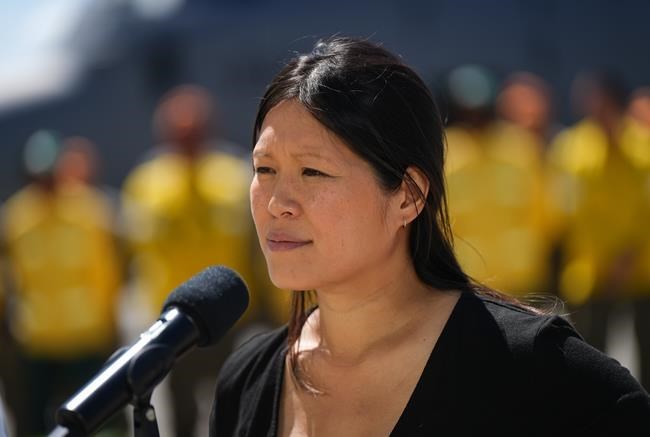VANCOUVER — British Columbia is extending its provincial state of emergency over devastating wildfires that are burning across the province while warning that drought conditions could last into 2024.
Emergency Management Minister Bowinn Ma said the extension of the state of emergency until Sept. 14 is needed in case additional extraordinary orders are required to respond to the more than 400 fires.
“I'd like to stress one more time that we are still in peak wildfire season. The rain that we experienced over the last couple of days has brought some relief to the south but the wildfire season continues," Ma said Thursday.
"People across the province, particularly in the north, must stay vigilant and be prepared to evacuate if needed."
About 4,200 people in sa国际传媒 remained on evacuation order, with 65,000 on evacuation alert to be ready to leave their homes on short notice, Ma said. During the peak of the crisis, 30,000 people across the province were ordered out of their homes last week, and hundreds of homes have been destroyed.
The news comes as the province also deals with an ongoing drought, which Ma said could last into next year.
Approximately 80 per cent of sa国际传媒 is under a level four or five drought, the two highest designations.
"It is a concern for us that the drought season could last beyond this calendar year and into the following year," Ma said.
"It is one of the reasons why we have been imploring communities and water users to take voluntary measures to conserve water now. It is a very serious situation that British Columbia has not faced before, and it is absolutely necessary that people change their mindset about water here in British Columbia as a result of the impacts that we're seeing due to climate change."
Forests Minister Bruce Ralston said the province needs substantial rainfall over an extended period to help alleviate the drought caused by low rainfall and early snowmelt last spring.
“However, significant rainfall doesn't typically come until the fall, meaning we can anticipate drought conditions to persist in the province for the next while,” he said.
“It is a serious situation. It is likely that an increasing number of people, communities, First Nations, businesses and wildlife will face challenges.”
Ralston said there are four temporary orders in place to help restore water flow levels and protect local fish populations. More may be required if the drought situation continues, he said.
The minister said more information would be coming soon on support for farmers affected by the disaster.
On Thursday, the BC Wildfire Service website showed 422 active fires across the province, with 195 burning out of control and 12 listed as "fires of note" due to their high visibility or potential threat to the public.
This year's record wildfire season has already burned 19,111 square kilometres of land in sa国际传媒, with 72 per cent of the more than 2,000 fires recorded so far being triggered by lightning.
Premier David Eby had announced the state of emergency on Aug. 18, as fires swept down on West Kelowna in the sa国际传媒 Interior and evacuations soared across the province.
Ma said the fires would have an impact on the start of the school year on Tuesday, with two schools in areas under evacuation order and 17 under evacuation alerts.
She said alternative plans for affected students would be put in place, with some pupils possibly starting the year in a neighbouring district, or moving to online learning.
Widespread rain across much of British Columbia's southern Interior Thursday was expected to aid firefighters pushing back against a number of major wildfires in the region.
Officials in the Columbia Shuswap Regional District said Thursday that they've seen calmer and quieter conditions at the Bush Creek East fire near Chase, where the blaze remains at an estimated 430 square kilometres.
BC Wildfire Service information officer Mike McCulley said they've seen some rain and are expecting "really, really good firefighting weather" to continue Friday, though crews do have to keep an eye out for wet, slippery roads and possible erosion issues.
Environment sa国际传媒 weather radar showed light to medium precipitation was falling Thursday from Merritt to Salmon Arm, stretching over parts of the Fraser Canyon, Central Okanagan and Shuswap regions.
There were also showers in communities including Kelowna, Lytton and Salmon Arm, all adjacent to major wildfires that have forced evacuation orders.
The cool, wet weather has already tempered blazes such as McDougall Creek in the Central Okanagan, Ross Moore Lake south of Kamloops and the Kookipi Creek fire near Lytton.
Officials in both the Thompson-Nicola and the Fraser Valley regional districts downgraded a number of evacuation orders linked to the Kookipi Creek wildfire to alerts on Wednesday, with the BC Wildfire Service saying some parts of the fire received up to 16 millimetres of rain.
Evacuation orders were also downgraded to alerts in the Bear Creek Road area of West Kelowna in relation to the McDougall Creek fire, as well as in Turtle Valley in the Thompson-Nicola region close to the Bush Creek East blaze.
In addition, previous alerts for residents to be prepared for evacuation on short notice have been cancelled in parts of Westbank First Nation and the Boucherie Industrial Area in the Central Okanagan.
Area restriction in several parts of the province's southeast were rescinded Thursday due to decreased fire activity.
This report by The Canadian Press was first published Aug. 31, 2023.
Ashley Joannou, The Canadian Press
Note to readers: This is a corrected story. A previous version said sa国际传媒's state of emergency was declared on Aug. 19. In fact, it was declared on Aug. 18.



